Carpet Manufacturing Process
Handmade rugs and carpets can be made in any shape, size, color or design. Although some carpets manufacturers use some special techniques in weaving a hand made carpet, but the principles of rug manufacturing from designing to finishing are almost the same throughout the world. These principles have changed very little over the centuries. Carpet manufacturing was started to the region now constituting Pakistan back in 11th century. For details History of Carpets in Pakistan
1. Designing / pattern
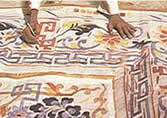 A detailed graphic diagram of the carpet design on a graph paper, known as naksha in Pakistan, leads the weavers throughout the entire rug manufacturing process. The drawing or naksha, is what the weavers follow to create their patterns. Traditionally, drawings have been drawn by hand on graph paper. Many carpet manufacturers in pakistan maintain that system. Each carpet even same in design but different in size must be scaled separately and design elements may be modified as necessary. Every design is drawn to scale on graph paper with a grid the same as the knot density to be utilized. For example one square inch having 20 vertical and 20 horizontal knots is equal to 400 knots per square inch (psi). The color of each knot is painted onto graph using paint colors or colored pencils.
A detailed graphic diagram of the carpet design on a graph paper, known as naksha in Pakistan, leads the weavers throughout the entire rug manufacturing process. The drawing or naksha, is what the weavers follow to create their patterns. Traditionally, drawings have been drawn by hand on graph paper. Many carpet manufacturers in pakistan maintain that system. Each carpet even same in design but different in size must be scaled separately and design elements may be modified as necessary. Every design is drawn to scale on graph paper with a grid the same as the knot density to be utilized. For example one square inch having 20 vertical and 20 horizontal knots is equal to 400 knots per square inch (psi). The color of each knot is painted onto graph using paint colors or colored pencils.There are two types of drawings.
Partial drawing or one corner drawing is designed mostly for traditional carpets, oriental carpets, bokhara rugs and tribal rugs which have the same design from four corners. The partial drawing shows the border and as much of the field as needed to establish the pattern.
Complete drawing is designed mostly for the contemporary rugs, designer rugs and modern rugs which have different design from each corner.
2. Wool washing & carding
The vast majority of rugs & carpets are woven from wool, and some more pricey carpets are made from fine silk. Wool is either imported or is bought from nearby markets. Pakistani carpets are made with both worsted wool imported from New Zealand and local wool (2 ply wool, 3 ply wool) only from the finest sheep. The process begins by shearing the wool. It is then washed in hot water and degreased, sometimes using soap, after which it is put in a bath for 20-24 hours and then sun dried for 2-3 days.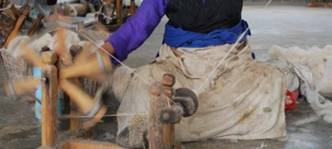 After drying the carding process starts it allows the fiber stand to flow smoothly while spinning. This stage is also for blending different wools. The carded wool is spun into yarn by using a spinning wheel or a charkha. The thickness of the yarn plays major role in the quality of the carpet. Handspun wool is a very important material and imparts a rich character of depth and brilliance in carpets & rugs.
After drying the carding process starts it allows the fiber stand to flow smoothly while spinning. This stage is also for blending different wools. The carded wool is spun into yarn by using a spinning wheel or a charkha. The thickness of the yarn plays major role in the quality of the carpet. Handspun wool is a very important material and imparts a rich character of depth and brilliance in carpets & rugs.
3. Dyeing
After the wool is spun into yarn, it must be dyed to produce color. Natural wool is transported to the dyer where two types of dyes are used. There are two types of dying processes.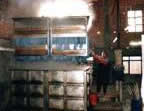 Synthetic
Synthetic
Synthetic dyes are chrome based, give a huge variety of colors and can be consistently reproduced. The synthetic dyes used today are excellent and far superior to the earlier aniline dyes. Chrome dyes quite often turn to last longer.
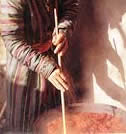 Natural (also, vegetal or vegetable dyes)
Natural (also, vegetal or vegetable dyes)
Natural dyes are extracted from plants and minerals that's why they are more beautiful. They provide a wide range of colors, some of which are difficult to achieve with synthetic dyes, and are nearly impossible to consistently replicate. Natural dyes are not toxic. They are not risky for the dyers and the environment.
Click to view vegetable dye carpets collection (Chobi - Ziegler, Kazak)
4. Base construction (warp and weft) & Knotting
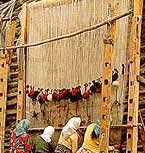 When the wool and the drawing are ready, then carpet manufacturer passes wool, drawing and cotton fiber (yarn) to carpet weaver. Cotton fiber has an important role in carpet weaving because warp and weft are normally made of cotton fiber. Sometimes wool and silk are also used for warp and weft.
When the wool and the drawing are ready, then carpet manufacturer passes wool, drawing and cotton fiber (yarn) to carpet weaver. Cotton fiber has an important role in carpet weaving because warp and weft are normally made of cotton fiber. Sometimes wool and silk are also used for warp and weft.
When the warp and wept completed. The weaver sits on a plank facing the loom, makes sure that he/she has some essential tools with him/her, and begins tying knots. Knotting is an art. Every knot is fastened separately, the opportunity of totally individual color registration and design is provided. read more
5. Trimming
 After the weaving of a carpet is completed; it is taken down from the loom. And then the final finishing steps starts. First, the selvedge edges (side edges of the carpet formed by the continuous weft) bound or overcast with yarn to strengthen the side edges of the carpet. Next, the warp ends (which secured the carpet to the loom) braided to form the rug's fringe.
After the weaving of a carpet is completed; it is taken down from the loom. And then the final finishing steps starts. First, the selvedge edges (side edges of the carpet formed by the continuous weft) bound or overcast with yarn to strengthen the side edges of the carpet. Next, the warp ends (which secured the carpet to the loom) braided to form the rug's fringe.
6. Washing and drying
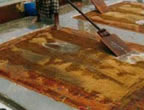 After that the carpet is washed by hand to remove the dust and dirt mounted up in the weaving process. In addition to washing, the type of washing can also expose a beautiful sheen and luster to the wool as well as soften or antique the rug's colors.
After that the carpet is washed by hand to remove the dust and dirt mounted up in the weaving process. In addition to washing, the type of washing can also expose a beautiful sheen and luster to the wool as well as soften or antique the rug's colors. The washed carpet is then dried in the sunlight up to four or five days.
7. Pile cutting
 When the carpet is washed and dried, a rug cutter shears the tops of the knots to create a uniform pile height. In the surface cutting process some carpets incised designs or feature carved to highlight various motifs.
When the carpet is washed and dried, a rug cutter shears the tops of the knots to create a uniform pile height. In the surface cutting process some carpets incised designs or feature carved to highlight various motifs.
8. Final touches
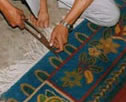 At final stage carpets are given final touches by stretching and re-trimming, whereever necessary. The objective is to bring the fabric woven in level at the surface.
At final stage carpets are given final touches by stretching and re-trimming, whereever necessary. The objective is to bring the fabric woven in level at the surface.